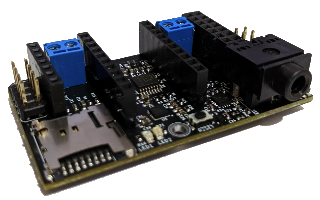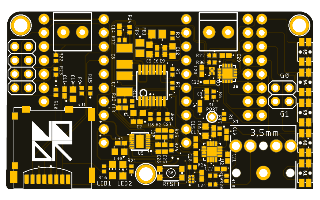The audio board solution specially crafted for the TinyPICO ESP32 development board.

The audio board solution specially crafted for the TinyPICO ESP32 development board.
The picoAUDIO board is an open source hardware project. All schematics, PCB layouts and gerber files are available on GitHub

A builtin memory card reader and amplified headphone jack provide flexability for your audio projects.

Directly power 4-8 ohm speakers from the builtin 3.7W class D amplifier.

In keeping with the PICO spirit, the picoAUDIO uses a 4 layer PCB and 0402 components to acheive a tiny form factor that packs a huge sound.
The following audio files have been recorded from the picoAUDIO’s headphone jack using a Native Instruments DAC connected to a PC. The files have not been processed in any way other than to trim the start and end of the files. They are indicative of the audio quality achieved by the board.
Recording Audio Chain |
||||||||
|---|---|---|---|---|---|---|---|---|
| MP3 File | picoAUDIO DAC |
picoAUDIO Headphone Amp |
PC DAC (+8dB) |
WAV File | ||||
A simple test of stereo seperation.
A full sweep across the audio spectrum showing the picoAUDIO's range and fidelity.
A recording of Deadmau5 / Where's The Drop? / Strobe (ov) from a MP3 file played via the SDCard slot.
The picoAUDIO is a fully featured audio solution specially made for the TinyPICO ESP32 development board, featuring an I2S Stereo DAC, I2S Mono MEMS Microphone, builtin 3.7W Stereo Amplifier, dedicated Headphone Amplifier, I2C GPIO Extender and built-in MicroSD card reader.
We utilise a low power NXP UDA1334A IC featuring a clear digital 16/20/24 bit, 44.1kHz, stereo audio DAC. Accompanying the DAC is a Knowles SPH0645 I2S digital mono microphone. This miniature low power MEMS microphone provides a low noise, 24 bit, 44.1kHz stream. Complimenting the DAC is the powerful Maxim MAX98306 3.7W stereo class D amplifier with stero speaker terminals and a Texas Instrumets TPA6132A2 stereo headphone amplifier with 3.5mm audio jack.
A simple mounting socket hosts the TinyPICO development board and connects all of these great features together in a seamless and easy to utilise footprint measuring a tiny 33 mm x 57 mm (1.29in x 2.24in). To provide maximum connectivity the board features a built-in MicroSD card reader and GPIO extender to hookup 8 inputs and outputs for all of your button and LED needs.
While the ESP32 does have two built-in DACs that are capable of generating stereo audio, the accuracy of these DACs is severely limited when compared to the dedicated audio codec found on the picoAUDIO. The default ESP32 DACs are 8bit whereas the picoAUDIO's DACs can operate at 16, 20 or 24bit. This is a much higher resolution, providing higher fidelity sound for your audio projects. Coupled with the built in microSD card reader you will be playing high quality audio in no time.
While a lot of audio boards provide an audio jack to connect your device to an external amplifier, few boards provide a properly amplified headphone audio jack. Many boards utilise large capacitors to drive headphones but create significant noise and distortion as a result. The picoAUDIO board uses a dedicated Texas Instruments headphone amplifier with selectable gain to provide high fidelity headphone audio.
